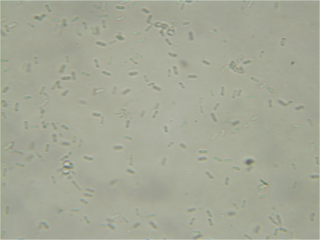Related Research Articles

The fungal order Agaricales, also known as gilled mushrooms or euagarics, contains some of the most familiar types of mushrooms. The order has 33 extant families, 413 genera, and over 13,000 described species, along with six extinct genera known only from the fossil record. They range from the ubiquitous common mushroom to the deadly destroying angel and the hallucinogenic fly agaric to the bioluminescent jack-o-lantern mushroom.
In 1909, the entomologist Carlo Emery noted that social parasites among insects tend to be parasites of species or genera to which they are closely related. Over time, this pattern has been recognized in many additional cases, and generalized to what is now known as Emery's rule. The pattern is best known for various taxa of Hymenoptera. For example, the social wasp Dolichovespula adulterina parasitizes other members of its genus such as Dolichovespula norwegica and Dolichovespula arenaria. Emery's rule is also applicable to members of other kingdoms such as fungi, red algae, and mistletoe. The significance and general relevance of this pattern are still a matter of some debate, as a great many exceptions exist, though a common explanation for the phenomenon when it occurs is that the parasites may have started as facultative parasites within the host species itself, but later became reproductively isolated and split off from the ancestral species, a form of sympatric speciation.

The Hygrophoraceae are a family of fungi in the order Agaricales. Originally conceived as containing white-spored, thick-gilled agarics, including Hygrophorus and Hygrocybe species, DNA evidence has extended the limits of the family, so it now contains not only agarics, but also basidiolichens and corticioid fungi. Species are thus diverse and are variously ectomycorrhizal, lichenized, associated with mosses, or saprotrophic. The family contains 25 genera and over 600 species. None is of any great economic importance, though fruit bodies of some Hygrocybe and Hygrophorus species are considered edible and may be collected for sale in local markets.

Phoma is a genus of common coelomycetous soil fungi. It contains many plant pathogenic species.

The Lecanoraceae are a family of lichenized fungi in the order Lecanorales. Species of this family have a widespread distribution.

Ombrophila is a genus of fungi in the family Helotiaceae. The genus contains 11 species. Elias Fries circumscribed Ombrophila in 1849.
Phaeoglaena is a genus of fungi in the class Dothideomycetes. The relationship of this taxon to other taxa within the class is unknown. The genus was first described by American plant ecologist Frederick Clements in 1909.
Wettsteinina is a genus of 23 fungi in the class Dothideomycetes. The type species Wettsteinina gigantospora was first described by Franz Xaver Rudolf von Höhnel in 1907. The relationship of this taxon to other taxa within the class is unknown.

The Ophioparmaceae are a small family of lichen-forming fungi in the order Umbilicariales. The family was circumscribed in 1988 by lichenologists Roderick Westgarth Rogers and H. Thorsten Lumbsch.

The corticioid fungi are a group of fungi in the Basidiomycota typically having effused, smooth basidiocarps that are formed on the undersides of dead tree trunks or branches. They are sometimes colloquially called crust fungi or patch fungi. Originally such fungi were referred to the genus Corticium and subsequently to the family Corticiaceae, but it is now known that all corticioid species are not necessarily closely related. The fact that they look similar is an example of convergent evolution. Since they are often studied as a group, it is convenient to retain the informal (non-taxonomic) name of "corticioid fungi" and this term is frequently used in research papers and other texts.

The Caliciaceae are a family of mostly lichen-forming fungi belonging to the class Lecanoromycetes in the division Ascomycota. Although the family has had its classification changed several times throughout its taxonomic history, the use of modern molecular phylogenetic methods have helped to establish its current placement in the order Caliciales. Caliciaceae contains 36 genera and about 600 species. The largest genus is Buellia, with around 300 species; there are more than a dozen genera that contain only a single species.

The hydnoid fungi are a group of fungi in the Basidiomycota with basidiocarps producing spores on pendant, tooth-like or spine-like projections. They are colloquially called tooth fungi. Originally such fungi were referred to the genus Hydnum, but it is now known that not all hydnoid species are closely related.
The Maleae are the apple tribe in the rose family, Rosaceae. The group includes a number of plants bearing commercially important fruits, such as apples and pears, while others are cultivated as ornamentals. Older taxonomies separated some of this group as tribe Crataegeae, as the Cydonia group, or some genera were placed in family Quillajaceae.

Diplomitoporus flavescens is a species of poroid crust fungus in the family Polyporaceae.

Strigulaceae is a family of lichen-forming fungi, one of two families in the order Strigulales. Recent (2020) molecular analysis of the type genus, Strigula, has led to a reallocation of the foliicolous species into six genera that correspond to well-delimited clades with diagnostic phenotype features.

Cordieritidaceae is a family of fungi in the order Cyttariales. Species in this family are saprobes or lichenicolous.
References
- ↑ Clements FE. (1909). The Genera of Fungi. Minneapolis: H.W. Wilson. pp. 65, 174.
- ↑ "Odontura Clem., The genera of Fungi: 65, 174, 1909". MycoBank. International Mycological Association. Retrieved 2013-05-25.
- ↑ Rehm H. (1912). "Zur Kenntnis der Discomyceten Deutschlands, Deutsch-Österreichs und der Schweiz". Berichte der Bayerischen Botanischen Gesellschaft (in German). 13: 102–206 (see p. 166).
- ↑ Lumbsch TH, Huhndorf SM. (December 2007). "Outline of Ascomycota – 2007". Myconet. Chicago, USA: The Field Museum, Department of Botany. 13: 1–58.